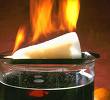Recently I read an opinion piece by Jon Bonne, wine editor for The San Francisco Chronicle, suggesting that high alcohol wines may be a matter of taste. Bonne doesn’t think that the age of the wine consumer is a factor, but he does caution that critics of the high alcohol trend shouldn’t draw a line above which no winemaker should dare to go. “Truth cannot be found between 13.9 and 14.1,” he says, drawing a thin line on the alcohol battleground.
That’s missing the point. Critics of high-octane wines, myself  included, are not trying to draw a magical line between what we deem as high alcohol and what we consider more moderate levels of alcohol. We’re simply saying, ‘Enough, already! Is the balance of a wine no longer important so long as winemakers reach even higher for more flavor?’
included, are not trying to draw a magical line between what we deem as high alcohol and what we consider more moderate levels of alcohol. We’re simply saying, ‘Enough, already! Is the balance of a wine no longer important so long as winemakers reach even higher for more flavor?’
As wine consumers we are urged to seek out wines that are balanced, or wines that present components like sugar, tannin, acidity, alcohol, on the same level plane. When one of these components throws the balance off, it’s immediately noticeable. With alcohol, the tell-tale sign of excess is a nose-prickling sensation and a measure of ‘heat,’ or alcohol burn, in the taste and the finish of the wine. It’s not a pleasant experience, and it spoils the pleasure of drinking a wine the same way that coarse unripe tannins, excessive sugar or acid would prompt the drinker to stop at one glass–or less.
 Apologists for high alcohol wines will also tell you that you’ll never notice that the wine contains 15% alcohol when you have it with food. Phooey! Maybe if I pair my red alcohol bomb with haunch of elephant! But even then, I don’t want my foods to have sledgehammer flavors anymore than I want my wines with a sign warning that they shouldn’t be poured near an open flame.
Apologists for high alcohol wines will also tell you that you’ll never notice that the wine contains 15% alcohol when you have it with food. Phooey! Maybe if I pair my red alcohol bomb with haunch of elephant! But even then, I don’t want my foods to have sledgehammer flavors anymore than I want my wines with a sign warning that they shouldn’t be poured near an open flame.
Further, Bonne and others point out that a number of high-alcohol wines (Spanish Garnacha, Chateauneuf-du-Pape, Zinfandel) present themselves just fine at 14-plus alcohols. And why is that? Because winemakers continue to push the envelope; squeezing every drop of flavor from every grape. To achieve high levels of ‘flavor ripeness’ means, of course, that natural grape sugars soar to heights not previously seen, and that means that in order to get the wine to dryness, alcohols also soar to new heights. So winemakers water the juice before fermentation or use mechanical devices to separate the alcohol from some of the wine, then back-blend that portion to achieve a lower overall alcohol. But, for some wine consumers these practices smack of voodoo winemaking or even worse, implying that winemakers are surreptitiously manipulating the wine. So, to achieve high levels of concentrated flavor, which the public supposedly demands, winemakers forgo the techniques and let the alcohols rise.
Granted, higher alcohols come easier with some varieties than others. The jammy flavors of Zinfandel are especially evident when the wine is at least 14% alcohol, while Riesling, planted in the right place, produces a flavorful wine at 12% or even 11% alcohol. But not everybody likes Zinfandel that smells and tastes like a jam pot, preferring a more subdued ‘claret’ style that doesn’t usually result in high alcohols.
There are, of course, other factors that define the growing conditions of certain grapes so that the final product is in balance and pleasurable to drink. I also admit that generalizing a complex issue doesn’t help get the point across. But I’ll close with one more quote from Bonne’s article, which I happen to agree with, but think demands a contextual comment: ‘…building a barrier at 12 percent doesn’t help to understand wine as it exists today.’ Point well put, but I would add that ‘understanding’ does not mean the same as ‘liking.’
6
